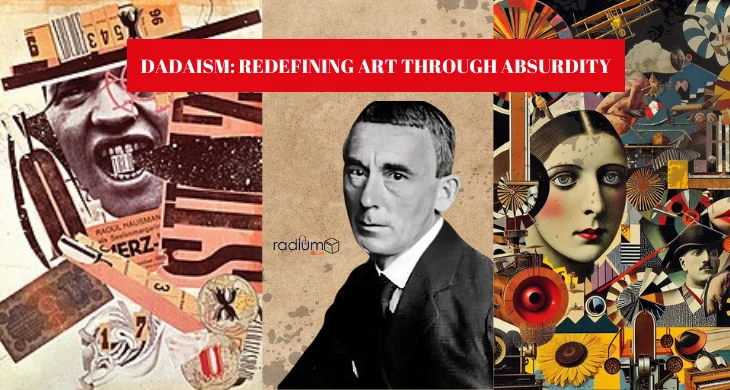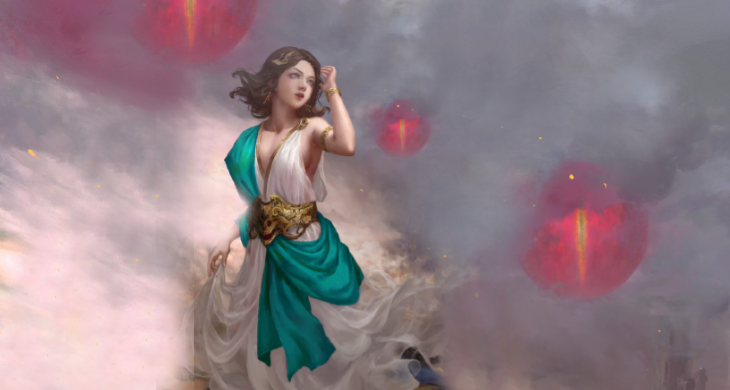Dadaism, born amid the turmoil of World War I, defied norms, embracing chaos and absurdity. This movement rejected traditional artistic conventions, aiming to provoke and challenge societal norms. Its origins trace back to Zurich, where artists sought to subvert established institutions and question the meaning of art itself. Notable figures like Marcel Duchamp, Tristan Tzara, and Hans Arp played pivotal roles, employing unconventional techniques such as ready-made, collage, and performance art. Dadaism’s impact reverberates through modern art, influencing subsequent movements like Surrealism and Conceptual Art. Today, its legacy endures as a testament to the power of artistic rebellion and the exploration of the nonsensical in a chaotic world.
What is Dadaism?
Dadaism, labeled as an anti-art movement, aimed to disrupt traditional artistic standards. Rejecting logic and coherence, it embraced randomness and absurdity as its guiding principles. Dadaists challenged the notion of art itself, questioning the need for rationality and aesthetic norms. Originating amidst the chaos of World War I, Dadaism emerged as a response to the societal disillusionment and upheaval of the time. Artists associated with the movement, such as Marcel Duchamp and Tristan Tzara, employed unconventional techniques like ready-mades and collage to convey their rejection of conventional artistic practices. Despite its relatively short-lived existence, Dadaism left a profound impact on the art world, influencing subsequent movements and inspiring artists to push the boundaries of creativity and expression.
Origins of Dadaism
Dadaism originated in the neutral city of Zurich amid the tumult of World War I. Artists, writers, and intellectuals converged in this haven, seeking solace from the chaos of the conflict. The movement arose from a collective sense of disillusionment with societal norms and cultural conventions, fueled by the horrors of war and the absurdity of human existence. Rejecting traditional artistic and literary forms, Dadaists embraced spontaneity, irreverence, and randomness as their guiding principles. Their aim was to dismantle established notions of art and culture, challenging the very foundations of rationality and coherence. Dadaist gatherings, characterized by provocative performances, nonsensical poetry readings, and absurd visual art, served as a platform for experimentation and subversion. Key figures such as Tristan Tzara, Hugo Ball, and Hans Arp played pivotal roles in shaping the movement’s ethos and spreading its influence beyond Zurich. Despite its short-lived existence, Dadaism left an indelible mark on the cultural landscape, paving the way for subsequent avant-garde movements and inspiring generations of artists to explore new realms of creativity and expression.
Dadaism Manifesto
Dadaism originated in the neutral city of Zurich amid the tumult of World War I. Artists, writers, and intellectuals converged in this haven, seeking solace from the chaos of the conflict. The movement arose from a collective sense of disillusionment with societal norms and cultural conventions, fueled by the horrors of war and the absurdity of human existence. Rejecting traditional artistic and literary forms, Dadaists embraced spontaneity, irreverence, and randomness as their guiding principles. Their aim was to dismantle established notions of art and culture, challenging the very foundations of rationality and coherence. Dadaist gatherings, characterized by provocative performances, nonsensical poetry readings, and absurd visual art, served as a platform for experimentation and subversion. Key figures such as Tristan Tzara, Hugo Ball, and Hans Arp played pivotal roles in shaping the movement’s ethos and spreading its influence beyond Zurich. Despite its short-lived existence, Dadaism left an indelible mark on the cultural landscape, paving the way for subsequent avant-garde movements and inspiring generations of artists to explore new realms of creativity and expression.
Key Characteristics
At the heart of Dadaism lies a profound embrace of chance, spontaneity, and irrationality. Dadaists, disillusioned by the rationality and orderliness that had led to the horrors of World War I, sought to disrupt conventional artistic norms and challenge the very notion of what constituted art. They turned to unconventional techniques such as collage, assemblage, and the use of ready-made objects to create works that defied traditional categorization and provoked thought. By repurposing everyday materials and incorporating found objects into their compositions, Dadaists sought to blur the boundaries between art and life, high and low culture, and the sacred and the profane. Their aim was not to create aesthetically pleasing or intellectually coherent artworks, but rather to shock, subvert, and destabilize the viewer’s expectations. Through their radical experimentation and rejection of established artistic conventions, Dadaists paved the way for the emergence of new forms of artistic expression and challenged the very foundations of artistic practice. Today, the legacy of Dadaism endures as a testament to the power of creative rebellion and the enduring importance of embracing the unpredictable and the irrational in the pursuit of artistic innovation.
Dadaism Artists
Prominent figures in the Dada movement, including Marcel Duchamp, Hugo Ball, and Tristan Tzara, played pivotal roles in pushing the boundaries of artistic expression and challenging entrenched conventions. Marcel Duchamp, known for his provocative works such as “Fountain,” which featured a urinal signed with a pseudonym, defied traditional notions of artistic craftsmanship and originality. Hugo Ball, a co-founder of the Cabaret Voltaire in Zurich, experimented with performance art and nonsensical poetry, embracing chaos and absurdity as a form of creative expression. Tristan Tzara, another key figure in the Dada movement, advocated for the use of random chance and spontaneity in art, famously declaring, “Dada is like your hopes: nothing.” Together, these artists sought to dismantle the hierarchical structures of the art world and democratize creativity, inviting audiences to question their preconceived notions of art and reality. Through their radical experimentation and refusal to conform to established norms, Duchamp, Ball, Tzara, and other Dadaists paved the way for the emergence of new artistic movements and challenged the very foundations of artistic practice. Their legacy continues to inspire contemporary artists to explore the boundaries of creativity and challenge the status quo.
Dadaism Influence
Despite its brief duration, Dadaism left an indelible mark on the trajectory of modern art, influencing a myriad of subsequent movements and schools of thought. Among these, Surrealism stands out as a direct descendant of Dadaism, with artists like Salvador Dalí and André Breton drawing inspiration from the Dadaists’ penchant for the irrational and the subconscious. The Fluxus movement, which emerged in the 1960s, embraced Dadaist principles of anti-authoritarianism and irreverence, emphasizing experimentation and audience participation. Similarly, Conceptual Art, with its focus on ideas rather than aesthetic objects, owes a debt to Dadaism’s emphasis on challenging traditional notions of art and artistic practice. The legacy of Dadaism reverberates throughout contemporary art practices, with artists continuing to explore themes of absurdity, chance, and subversion in their work. By questioning the fundamental assumptions underlying artistic creation and engaging with the absurdities of modern life, Dadaism paved the way for a more expansive and inclusive conception of art, one that continues to shape the artistic landscape to this day.
Legacy of Dadaism
At the heart of Dadaism lies a revolutionary spirit that defied the conventions of its time, ushering in a new era of artistic exploration and innovation. By rejecting traditional artistic values and embracing the absurd, Dadaists shattered the boundaries of what was considered acceptable in art, opening up new possibilities for creative expression. This radical reimagining of the artistic landscape laid the foundation for the experimental spirit that would come to define much of 20th and 21st-century art. Dadaism’s influence can be seen in the works of countless artists who have sought to challenge the status quo and push the boundaries of artistic convention. From the surreal landscapes of Salvador Dalí to the provocative performances of Marina Abramović, the legacy of Dadaism continues to inspire and inform contemporary art practice. By daring to question the fundamental assumptions of art and society, Dadaism unleashed a wave of creativity that continues to shape the artistic landscape to this day, reminding us of the transformative power of radical imagination and the enduring legacy of artistic rebellion.
Dadaism Today
Although Dadaism as a defined movement may have dissipated over time, its essence remains vibrant and relevant in the practices of contemporary artists. The ethos of Dadaism, characterized by a rejection of traditional artistic values and a penchant for subversion, continues to resonate with artists who seek to challenge the status quo and defy conventional norms. In today’s art world, themes of absurdity, randomness, and anti-authoritarianism—hallmarks of Dadaism—are prevalent, reflecting an ongoing fascination with the unconventional and the avant-garde. Contemporary artists draw inspiration from the Dadaist spirit, infusing their work with elements of surprise, irreverence, and playful experimentation. From performance art that blurs the boundaries between reality and fiction to conceptual pieces that provoke thought and introspection, the legacy of Dadaism endures in the diverse and dynamic landscape of contemporary art. By embracing the principles of Dadaism, artists continue to challenge societal norms, question established structures, and push the boundaries of artistic expression, ensuring that the spirit of rebellion and innovation ignited by the Dadaists lives on in the art of today and tomorrow.
Conclusion
In conclusion, Dadaism stands as a powerful symbol of artistic rebellion and creative liberation. Its enduring legacy reminds us of the transformative potential of art to disrupt, challenge, and provoke thought. By pushing the boundaries of conventional expression and embracing the absurd, Dadaism invites viewers to reconsider their perceptions of reality and embrace the unconventional. Through its innovative approach and fearless spirit, Dadaism continues to inspire artists and audiences alike, sparking conversations and igniting imaginations. As we reflect on its impact, we recognize Dadaism as more than just an art movement—it’s a revolutionary force that reshaped the artistic landscape and continues to shape our understanding of the world around us.
FAQs
Que: What is the significance of Dadaism in art history?
Ans: Dadaism represents a radical departure from traditional artistic conventions, challenging audiences to rethink their understanding of art and aesthetics.
Que: Who were some influential Dadaist artists?
Ans: Prominent Dadaists include Marcel Duchamp, Hugo Ball, Tristan Tzara, and Hannah Höch, among others.
Que: How did Dadaism influence subsequent art movements?
Ans: Dadaism laid the groundwork for Surrealism, Fluxus, and Conceptual Art, inspiring artists to embrace randomness, absurdity, and nonconformity.
Que: Is Dadaism still relevant today?
Ans: While the formal Dadaist movement may have ended, its ethos continues to influence contemporary artists who seek to challenge established norms and push the boundaries of artistic expression.
Que: How did Dadaism emerge as a response to World War I?
Ans: Dadaism emerged in the aftermath of World War I as a reaction to the chaos, violence, and disillusionment of the time, serving as a form of artistic protest against the horrors of war.




